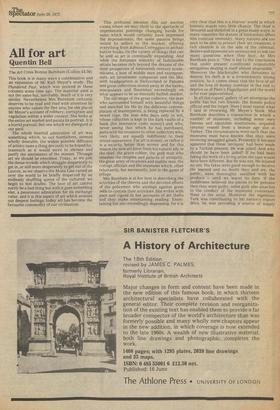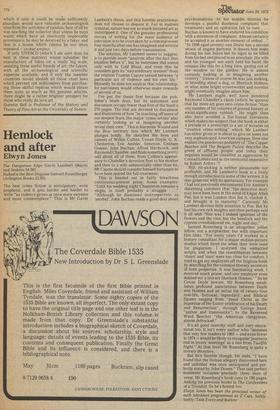All for art
Quentin Bell
The Art Crisis Bonnie Burnham (Collins £4.50)
This book is in many ways a continuation and an expansion of Mr Karl Meyer's study: The Plundered Past, which was noticed in these columns some time ago. The material used is not the same but, inevitably, much of it is very similar. Nevertheless Mrs Burnham certainly deserves to be read and read with attention by anyone who values the fine arts, for she places Mr Meyer's account of robbery, corruption and vapdalism within a wider context. She looks at the entire art Market and paints its portrait. It is a horrid portrait; but one which we disregard at our peril.
The whole hearted admiration of art was something which, to our forefathers, seemed wholly desirable, the widest possible diffusion of artistic taste a thing devoutly to be hoped for, inasmuch as it would serve to elevate and purify the sentiments of the masses. Through art we should be ennobled. Today, as we join the dense crowds which struggle desperately to get in, or still more desperately to get out of the Louvre, as we observe the Mona Lisa carted all over the world to be briefly inspected by an endlessly shuffling queue of the cultured, we begin to feel doubts. The love of art cannot surely be a bad thing but with it goes something else, a passionate admiration for its exchange value, and it is this aspect of art which arouses our deepest feelings, today art has become the favourite commodity of our civilisation.
This profound emotion fills our auction rooms where we may thrill to the spectacle of impressionist paintings changing hands for sums which would certainly have impressed the impressionists; the same passion brings would be sellers to the market, offering everything from dubious Correggios to archaic button hooks, for the variety of things that can be sold as art is continually expanding. And while the fortunate minority of fashionable artists becomes rich beyond the dreams of the most prosperous of nineteenth century academicians, a host of middle men and entrepreneurs, art investment companies and the like, with headquarters in Switzerland or Panama and great collections stored away in the banks, manipulates and flourishes exceedingly on what appears to be an eternally bullish market.
The old image of the great collector, the man who surrounded himself with beautiful things and enriched his life by the delicious contemplation of masterpieces, is being replaced by a newer type, the man who buys only to sell, whose c011ection is kept in the dark vaults of a bank (for insurance costs money) and who, never seeing that which he has purchased, parts with his treasures to other collectors who, very likely, are equally indifferent to their actual appearance. For art is money, or rather it is a security better than money and for this reason the new art lover finds his natural ally in the thief, the grave robber, the grab man who smashes the temples and palaces of antiquity, the great army of receivers and middle men, the corrupt officials and the museums which, often reluctantly, but necessarily, join in the game of pillage.
Mrs Burnham is at her best in describing the activities of the thieves and the devoted efforts of the policemen who attempt against great odds to contain their activities. She writes with pace and vigour in her accounts of art thefts and they make entertaining reading. Entertaining but also exceedingly depressing, for it is
very clear that this is a thieves' world in which honesty stands very little chance. The thief is favoured and sheltered in a great many ways: in many countries the statute of limitations offers him eventual immunity, many nations are too poor to be able to protect their art treasures, a rich clientele is on the side of the criminal, dealers and museums are anxious not to ask too many questions when they buy. As Mrs Burnham puts it: "One is led to the conclusion that under present conditions responsible antiquities dealing is itself almost imposSible." Moreover the blackmailer who threatens to destroy his theft is in a tremendously strong position. So it comes about that the love of art and the love of money combine in the end to deprive us of Piero's Flagellation and the world is for ever impoverished. , In all this rogues' gallery of art enterprise the public has but two friends: the honest police official and the forger. Here I must repeat what I said in reviewing Mr Meyer's book. Mrs Burnham describes a transaction in which a number of museums, including some very famous and reputable institutions, acquired ceramic vessels from a bronze age site in Turkey. The circumstances were such that the museums must have known that they were receiving smuggled goods. Presently it became apparent that these 'antiques' had been made by a Turkish peasant. He was jailed. And why should he have been jailed? If he had been faking the work of a living artist the case would have been different. But he was not. He injured no one. His fakes were good enough to deceive the learned andno doubt they and we, the public, were thoroughly satisfied with his produce — until we learnt its date. If the middlemen believed the pieces to be genuine then they were -guilty, some guilt also attaches to the conduct of the museums concerned. None to the artist. Moreover the ingenious Turk was contributing to his nation's export drive, he was providing a source of supply
which if only it could be made sufficiently abundant would save valuable archaeological sites from the activities of vandals; best of all he was teaching the collector that unless he buys wares which have an absolutely impeccable provenance, he may be deceived by a faker, and that is a lesson which cannot be too often repeated — caveat emptor.
If only UNESCO (which I am sure does its best in these matters) would subsidise the manufacture of fakes on a really big scale, assisting these useful friends of art, the fakers, with all the archaeological and scientific expertise available, and if only the member countries would abolish all those cruel laws which prevent our millionaires from purchasing those skilful replicas which would please them quite as much as the genuine articles, there might be a rather brighter prospect for those who really do love art.
Quentin Bell is Professor of the History and Theory of Fine Art at the University of Sussex



































 Previous page
Previous page